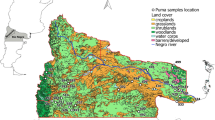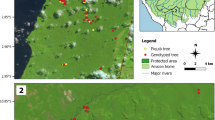Abstract
São Paulo is the most populous, developed and industrialized state of Brazil. Despite of intensive human activities, large habitat loss and fragmentation of the native vegetation cover, pumas (Puma concolor) still inhabit remnant habitat fragments in the northeastern area of the state. We investigated the occurrence of genetic structure and levels of genetic variability on pumas to aggregate basic information for conservation efforts to maintain long term viable populations of this top-predator in the region. By analyzing microsatellite loci variation, we corroborated the hypothesis of absence of genetic structure, and estimated high levels of genetic diversity (expected heterozygosity of 0.79 and mean of 10 alleles per locus). In spite of the increasing number of roadkilling and puma-human conflicts in the area, apparently pumas still maintain some level of gene flow between protected areas of the region. The observed excess of heterozygotes suggests a recent bottleneck event in this population, probably a consequence of the profound landscape transformation of the studied area during the last century; another possibility is this may be due to the observed deviation in the population sex ratio, which may be influencing the pumas’ mating system. We propose that: (1) landscape management in the study area should be focused on increasing habitat connectivity, creating protected areas and structures to allow highway crossing of pumas; (2) educational actions should be undertaken to change community perception of large carnivores, and possibly the implementation of compensatory actions to ranchers.

Similar content being viewed by others
References
Anderson CR, Lindzey FG, McDonald DB (2004) Genetic structure of cougar populations across the Wyoming basin: metapopulation or megapopulation. J Mammal 85:1207–1214
Biota/Fapesp (2008) Diretrizes para a conservação e restauração da biodiversidade no estado de São Paulo. Instituto de Botânica, FAPESP—Fundação de Amparo à Pesquisa do Estado de São Paulo, Programa Biota/FAPESP, São Paulo, Brasil
Blouin M (2003) DNA-based methods for pedigree reconstruction and kinship analysis in natural populations. TREE 18:503–511
Blouin MS, Parsons M, LaCaille V, Lotz S (1996) Use of microsatellite loci to classify individuals by relatedness. Mol Ecol 5:393–401
Bouzat JL (2010) Conservation genetics of population bottlenecks: the role of chance, selection and history. Conserv Genet 11:463–478
Broquet T, Petit E (2004) Quantifying genotyping errors in noninvasive population genetics. Mol Ecol 13:3601–3608
Chiarello AG (2000) Conservation value of a native forest fragment in a region of extensive agriculture. Braz J Zool 60:237–247
Cornuet JM, Luikart G (1996) Description and power analysis of two tests for detecting recent population bottlenecks from allele frequency data. Genetics 144:2001–2014
Culver M, Johnson WE, Pecon-Slattery J, O’Brien SJ (2000) Genomic ancestry of the American puma (Puma concolor). J Hered 91:186–197
Dean W (1996) With broadax and firebrand: the destruction of the Brazilian Atlantic Forest. University of California Press, Berkeley
Ernest HB, Boyce WM, Bleich VC, May B, Stiver SJ, Torres SG (2003) Genetic structure of mountain lion (Puma concolor) populations in California. Conserv Genet 4:353–366
Farrel LE, Roman J, Sunquist ME (2000) Dietary separation of sympatric carnivores identified by molecular analysis of scats. Mol Ecol 9:1583–1590
Goudet J (1995) FSTAT, a computer program to calculate F statistics. J Hered 86:485–486
Guo S, Thompson E (1992) Performing exact test of Hardy–Weinberg proportion for multiple alleles. Biometrics 48:361–372
Haag T, Santos AS, Sana DA, Morato RG, Cullen L Jr, Crawshaw PG Jr, De Angelo C, Di Bitetti MS, Salzano FM, Eizirik E (2010) The effect of habitat fragmentation on the genetic structure of a top predator: loss of diversity and high differentiation among remnant populations of Atlantic Forest jaguars (Panthera onca). Mol Ecol 19:4906–4921
Haines AM, Janecka JE, Tewes ME, Grassman LI, Morton P (2006) The importance of private lands for ocelot Leopardus pardalis conservation in the United States. Oryx 40:1–5
IBGE (2009) Estimativas das populações residentes, segundo os municípios em 1 de julho de 2009. Instituto Brasileiro de Geografia e Estatística http://www.ibge.gov.br/home/estatistica/populacao/estimativa2009. Accessed 30 May 2010
Kalinowski ST, Wagner AP, Taper ML (2006) ML-Relate: a computer program for maximum likelihood estimation of relatedness and relationship. Mol Ecol Notes 6:576–579
Kurushima JD, Collins JW, Ernest HB (2006) Development of 21 microsatellite loci for puma (Puma concolor) ecology and forensics. Mol Ecol Notes 6:1260–1262
Lindzey FG, Van Sickle WD, Ackerman BB, Barnhurst D, Hemker TP, Laing SP (1994) Cougar population dynamics in southern Utah. J Wildl Manag 58:619–624
Logan KA, Sweanor LL (2001) Desert Puma: evolutionary ecology and conservation of an enduring carnivore. Island Press, Washington
Luikart G, Sherwin WB, Steele BM, Allendorf FW (1998) Usefulness of molecular markers for detecting population bottlenecks via monitoring genetic change. Mol Ecol 7:963–974
Lyra-Jorge MC, Ciocheti G, Pivello VR (2008) Carnivore mammals in a fragmented landscape in northeast of São Paulo state. Biodivers Conserv 17:1573–1580
Menotti-Raymond M, O’Brien SJ (1995) Evolutionary conservation of ten microsatellite loci in four species of Felidae. J Hered 86:319–322
Miotto RA, Rodrigues FP, Ciocheti G, Galetti Junior PM (2007) Determination of the minimum population size of pumas (Puma concolor) through faecal DNA analysis in two protected cerrado areas in the Brazilian Southeast. Biotropica 39:647–654
Miotto RA, Cervini M, Begotti RA, Galetti Junior PM (2011) Monitoring a puma (Puma concolor) population in a fragmented landscape in the Brazilian southeast. Biotropica. doi:10.1111/j.1744-7429.2011.00772.x
Paetkau D, Waits LP, Clarkson PL, Craibghead L, Vyse E, Ward R, Strobeck C (1998) Variation in genetic diversity across the range of North American brown bears. Conserv Biol 12:418–429
Pearse DE, Crandall KA (2004) Beyond FST: analysis of population genetic data for conservation. Conserv Genet 5:585–602
Pilgrim KL, McKelvey KS, Riddle AE, Schwartz MK (2005) Felid sex identification based on noninvasive genetic samples. Mol Ecol Notes 5:60–61
Piry SG, Luikart G, Cornuet JM (1999) BOTTLENECK: a computer program for detecting recent reductions in the effective population size using allele frequency data. J Hered 90:502–503
Pritchard JK, Stephens P, Donnelly P (2000) Inference of population structure using multilocus genotype data. Genetics 155:945–959
Rabinowitz AR (1986) Jaguar predation on domestic livestock in Belize. Wildl Soc Bull 14:170–174
Raymond M, Rousset F (1995) Genepop: population genetics software for exact tests and ecumenicism. J Hered 86:248–249
Ribeiro MC, Metzger JP, Martensen AC, Ponzoni FJ, Hirota MM (2009) The Brazilian Atlantic Forest: How much is left, and how is the remaining forest distributed? Implications for conservation. Biol Conserv 142:1141–1153
Riley SPD, Pollinger JP, Sauvajot RM, York EC, Bromley C, Fuller TK, Wayne RK (2006) A southern California freeway is a physical and social barrier to gene flow in carnivores. Mol Ecol 15:1733–1741
Ross PL, Jalkotzy MG (1992) Characteristics of a hunted population of cougars in southwestern Alberta. J Wildl Manag 56:417–426
Ruiz-Garcia M (2001) Diversidad genética como herramienta de zonificación ambiental: estudios moleculares (microsatélites) en el caso de primates y félidos neotropicales comportan una nueva perspectiva. In: Libro de memorias Defler TR, Palacios PA (eds) Zonificación Ambiental para el Ordenamiento territorial. Instituto Amazónico de Investigaciones Imani & Instituto de Ciencias Naturales. Universidad Nacional de Colombia, Bogotá
Ruth TK, Logan KA, Sweanor L, Hornocker MG, Temple LJ (1998) Evaluating cougar translocation in New Mexico. J Wildl Manag 62:1264–1275
Sambrook J, Fritsch EF, Maniatis T (1989) Molecular cloning: a laboratory manual, 2nd edn. Cold Spring Harbor Press, New York
Schuelke M (2000) An economic method for the fluorescent labeling of PCR fragments. Nat Biotechnol 18:233–234
Sergio F, Caro T, Brown D, Clucas B, Hunter J, Ketchum J, McHugh K, Hiraldo F (2008) Top predators as conservation tools: ecological rationale, assumptions, and efficacy. Annu Rev Ecol Evol Syst 39:1–19
Simberloff D (1998) Flagships, umbrellas, and keystones: Is single-species management passé in the landscape era? Biol Conserv 83:247–257
Sinclair EA, Swenson EL, Wolfe ML, Choate DC, Gates B, Cranall KA (2001) Gene flow estimates in Utah’s cougars implies management beyond Utah. Anim Conserv 4:257–264
Taberlet P, Griffin S, Goossens B, Questiau S, Manceau V, Escaravage N, Waits LP, Bouvet J (1996) Reliable genotyping of samples with very low DNA quantities using PCR. Nucleic Acids Res 24:3189–3194
Terborgh J, Lopez L, Nuñez P, Rao M, Shahabuddin G, Orihuela G, Riveros M, Ascanio R, Adler GH, Lambert TD, Balbas L (2001) Ecological meltdown in predator-free forest fragments. Science 294:1923–1926
Treves A, Karanth KU (2003) Human-carnivore conflict and perspectives on carnivore management worldwide. Conserv Biol 17:1491–1499
Valière N (2002) Gimlet: a computer program for analyzing genetic individual identification data. Mol Ecol Notes 2:377–379
Van Oosterhout C, Hutchinson WF, Wills DPM, Shipley P (2004) Micro-checker: software for identifying and correcting genotyping errors in microsatellite data. Mol Ecol Notes 4:535–538
Verdade LM, Campos CB (2004) How much is a puma worth? Economic compensation as an alternative for the conflict between wildlife conservation and livestock production in Brazil. Biota Neotrop 4:1–4
Waits LP, Luikart G, Taberlet P (2001) Estimating the probability of identity among genotypes in natural populations: cautions and guidelines. Mol Ecol 10:249–256
Walker CW, Harveson LA, Pittman MT, Tewes ME, Honeycutt RL (2000) Microsatellite variation in two populations of mountain lions (Puma concolor) in Texas. Southwest Nat 45:196–203
Waples RS (2006) A bias correction for estimates of effective population size based on linkage disequilibrium at unlinked gene loci. Conserv Genet 7:167–184
Waples RS, Do C (2008) LDNE: a program for estimating effective population size from data on linkage disequilibrium. Mol Ecol Res 8:753–756
Weber W, Rabinowitz A (1996) A global perspective on large carnivore conservation. Conserv Biol 10:1046–1054
Weir BS, Cockerham CC (1984) Estimating F-statistics for the analysis of population structure. Evolution 38:1358–1370
Acknowledgments
We are very grateful to Fapesp, CNPq and Capes agencies for their financial support; to the NGO Neotropical Grassland Conservancy for supplying laboratory reagents; to Dra. Karin Werther (UNESP/Jaboticabal), CENAP/IBAMA, Parque Ecológico de São Carlos and Polícia Ambiental do estado de São Paulo for given samples and informations on injured or dead animals in the study area; to the International Paper do Brasil for allowing and supporting field expeditions into private areas; to the ‘Radiotelemetria Digital’ team project for collecting samples; to Giordano Ciocheti for their help in field work and innumerous discussions on puma’s habits and conservation strategies.
Author information
Authors and Affiliations
Corresponding author
Electronic supplementary material
Below is the link to the electronic supplementary material.
Rights and permissions
About this article
Cite this article
Miotto, R.A., Cervini, M., Figueiredo, M.G. et al. Genetic diversity and population structure of pumas (Puma concolor) in southeastern Brazil: implications for conservation in a human-dominated landscape. Conserv Genet 12, 1447–1455 (2011). https://doi.org/10.1007/s10592-011-0243-8
Received:
Accepted:
Published:
Issue Date:
DOI: https://doi.org/10.1007/s10592-011-0243-8




